steering wheel CHEVROLET SUBURBAN 1994 Owners Manual
[x] Cancel search | Manufacturer: CHEVROLET, Model Year: 1994, Model line: SUBURBAN, Model: CHEVROLET SUBURBAN 1994Pages: 385, PDF Size: 19.88 MB
Page 65 of 385
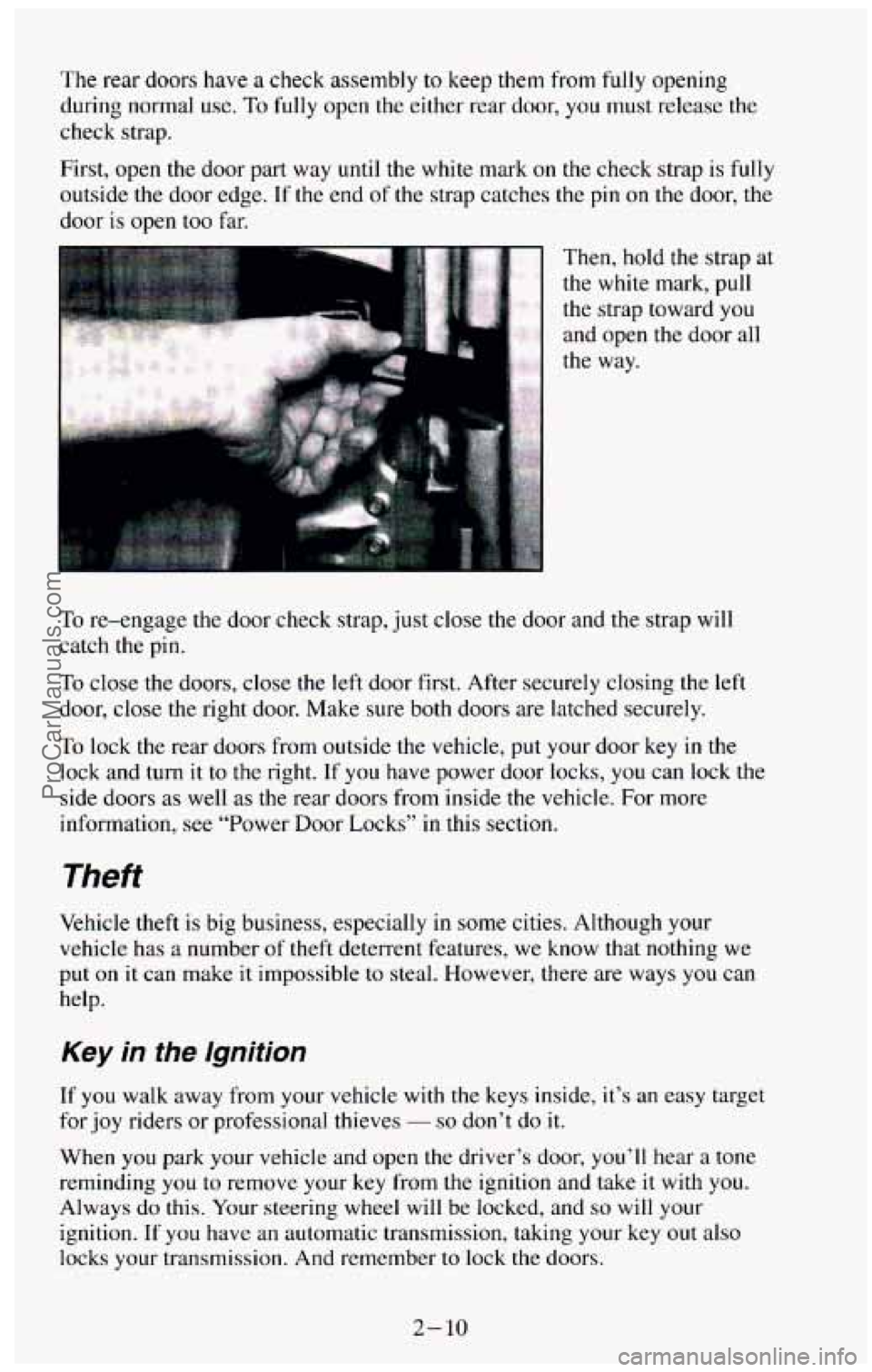
The rear doors have a check assembly to keep them from fully opening
during normal use.
To fully open the either rear door, you must release the
check strap.
First, open the door part way
until the white mark on the check strap is fully
outside the door edge. If the end of the strap catches the pin on the door, the
door is open too far,
Then, hold the strap at
the white mark, pull
the strap toward
you
and open the door all
the way.
To re-engage the door check strap, just close the door and the strap will
catch the pin.
To close the doors, close the left door first. After securely closing the left
door, close the right door. Make sure both doors are latched securely.
To lock the rear doors from outside the vehicle, put your door key in the
lock and turn it to the right. If you have power door locks, you can lock the
side doors as well as the rear doors from inside the vehicle. For more
information, see “Power Door Locks” in this section.
Theft
Vehicle theft is big business, especially in some cities. Although your
vehicle has a number of theft deterrent features, we
know that nothing we
put
on it can make it impossible to steal. However, there are ways you can
help.
Key in the lgnition
If you walk away from your vehicle with the keys inside, it’s an easy target
for
joy riders or professional thieves - so don’t do it.
When you park your vehicle and open the driver’s door, you’ll hear a tone
reminding
you to remove your key from the ignition and take it with you.
Always
do this. Your steering wheel will be locked, and so will your
ignition.
If you have an automatic transmission, taking your key out also
locks your transmission. And remember to lock the doors.
2- 10
ProCarManuals.com
Page 67 of 385
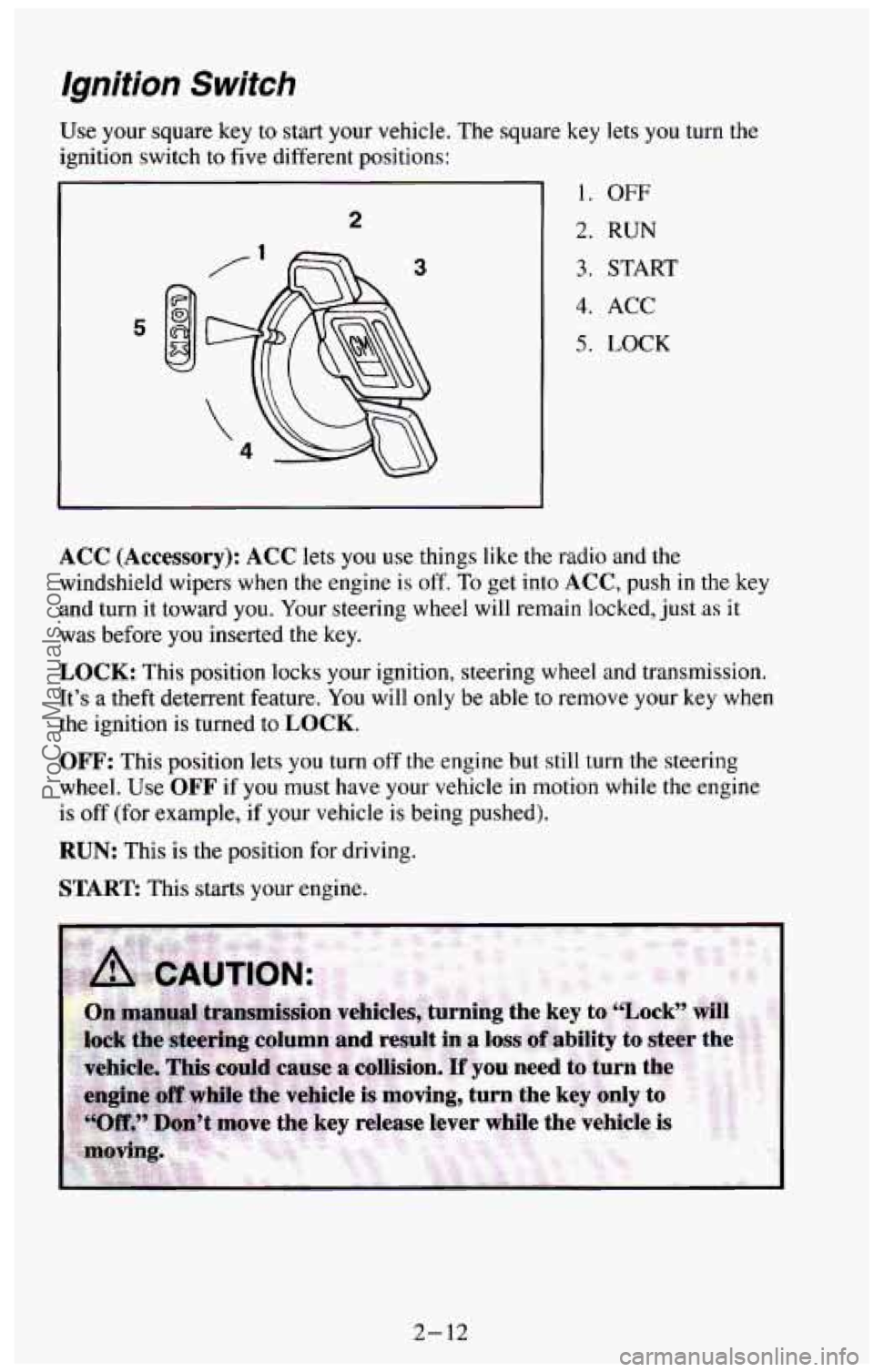
Ignition Switch
Use your square key to start your vehicle. The square key lets you turn the
ignition switch to five different positions: -
I
5
2
3
1. OFF
2. RUN
3. START
4. ACC
5. LOCK
ACC (Accessory): ACC lets you use things like the radio and the
windshield wipers when the engine is
off. To get into ACC, push in the key
and turn it toward you. Your steering wheel
will remain locked, just as it
was before
you inserted the key.
LOCK: This position locks your ignition, steering wheel and transmission.
It’s a
theft deterrent feature. You will only be able to remove your key when
the ignition is turned to LOCK.
OFF: This position lets you turn off the engine but still turn the steering
wheel. Use
OFF if you must have your vehicle in motion while the engine
is
off (for example, if your vehicle is being pushed).
RUN: This is the position for driving.
START This starts your engine.
2- 12
ProCarManuals.com
Page 68 of 385
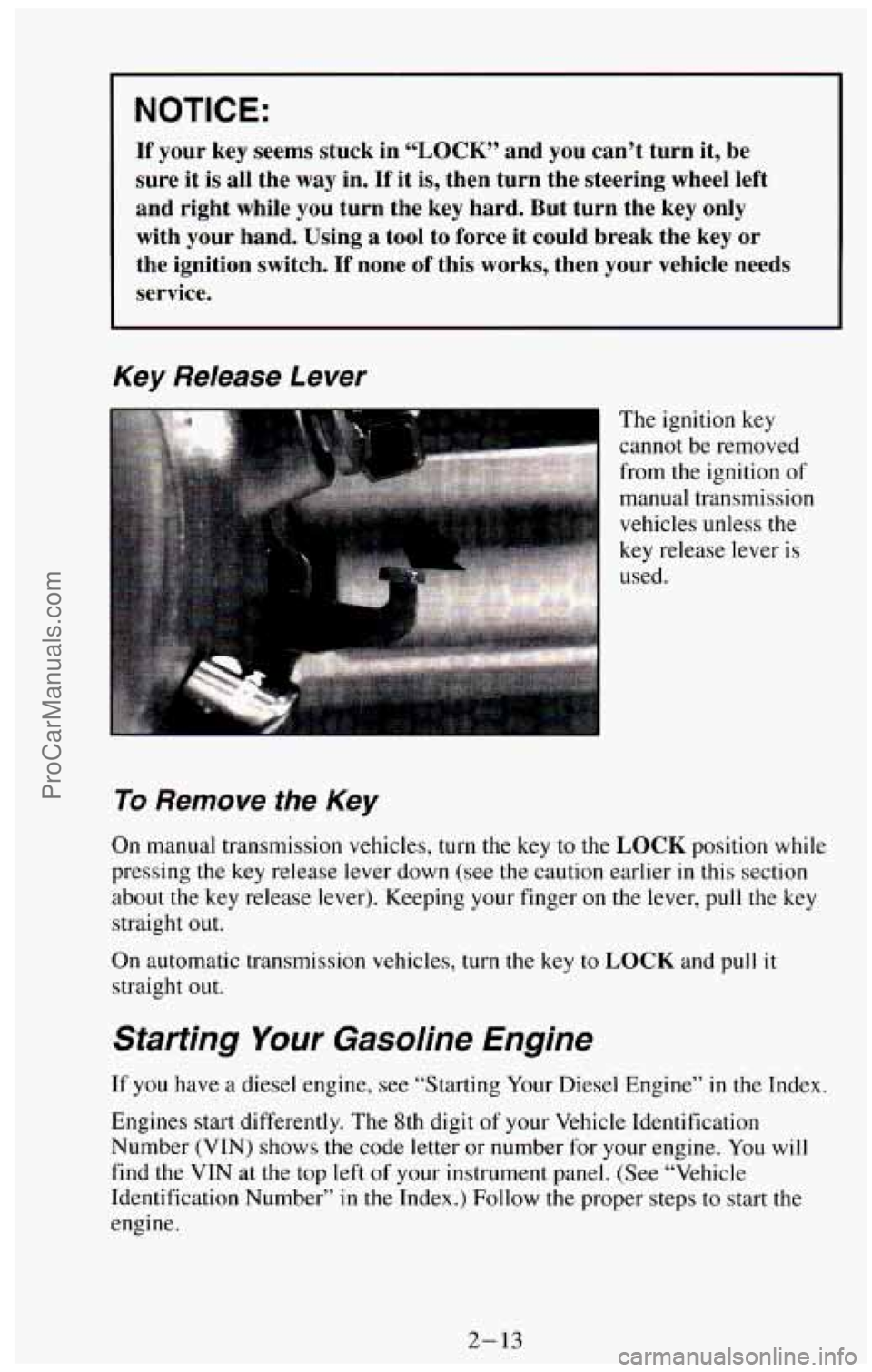
NOTICE:
If your key seems stuck in “LOCK” and you can’t turn it, be
sure it is all the way in.
If it is, then turn the steering wheel left
and right while
you turn the key hard. But turn the key only
with your hand. Using a tool to force
it could break the key or
the ignition switch.
If none of this works, then your vehicle needs
service.
Key Release Lever
The ignition key
cannot be removed
from the ignition of
.. manual transmission
vehicles unless the
To Remove the Key
On manual transmission vehicles, turn the key to the LOCK position while
pressing the key release lever down (see the caution earlier
in this section
about the key release lever). Keeping your finger
on the lever, pull the key
straight out.
On automatic transmission vehicles, turn the
key to LOCK and pull it
straight out.
Starting Your Gasoline Engine
If you have a diesel engine, see “Starting Your Diesel Engine” in the Index.
Engines start differently. The
8th digit of your Vehicle Identification
Number (VIN) shows the code letter or number for your engine.
You will
find the VIN at the top left of your instrument panel. (See “Vehicle
Identification Number” in
the Index.) Follow the proper steps to start the
engine.
2-13
ProCarManuals.com
Page 83 of 385

Shifting Into “P” (Park)
(Automatic Transmission Models Only)
Steering Column Shift Lever
1. Hold the brake
pedal down with
your right
foot
and set the
parking brake.
2. Move the shift lever into “P” (Park) position like this:
0 Pull the lever toward you.
0 Move the lever up as far as it will go.
3. If you have four-wheel drive, be sure the transfer case is in a drive gear
- not in “N’ (Neutral)
4. Move the ignition key to LOCK.
2-28
ProCarManuals.com
Page 92 of 385
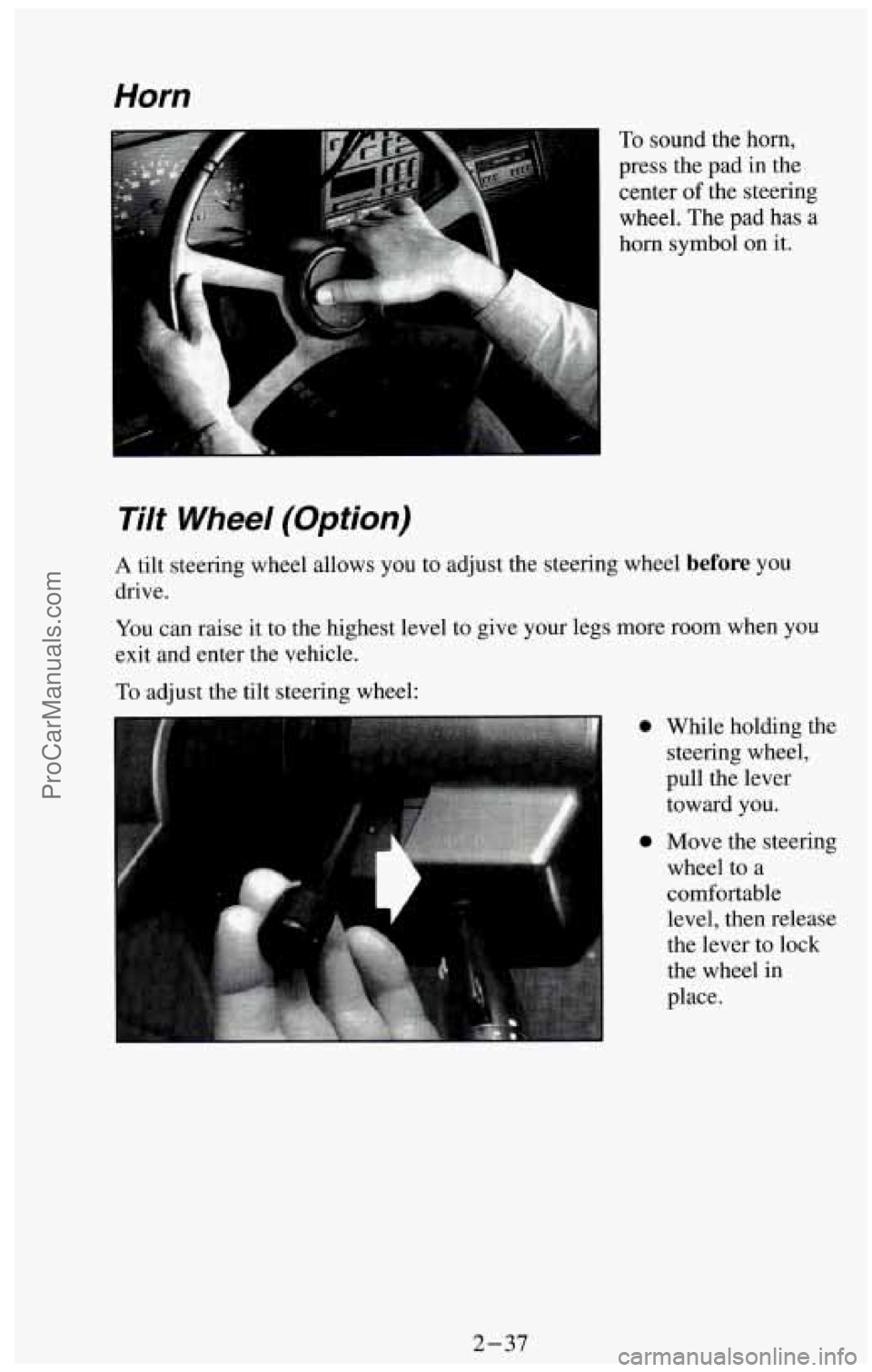
Horn
To sound the horn,
press the pad in the
center of the steering
wheel. The pad has a
Tilt Wheel (Option)
A tilt steering wheel allows you to adjust the steering wheel before you
drive.
You can raise it to the highest level to give your legs more room when you
exit and enter the vehicle.
To adjust the tilt steering wheel:
0 While holding the
steering wheel,
pull the lever
toward you.
0 Move the steering
wheel to a
comfortable
level, then release
the lever to lock
the wheel in
place.
2-37
ProCarManuals.com
Page 109 of 385
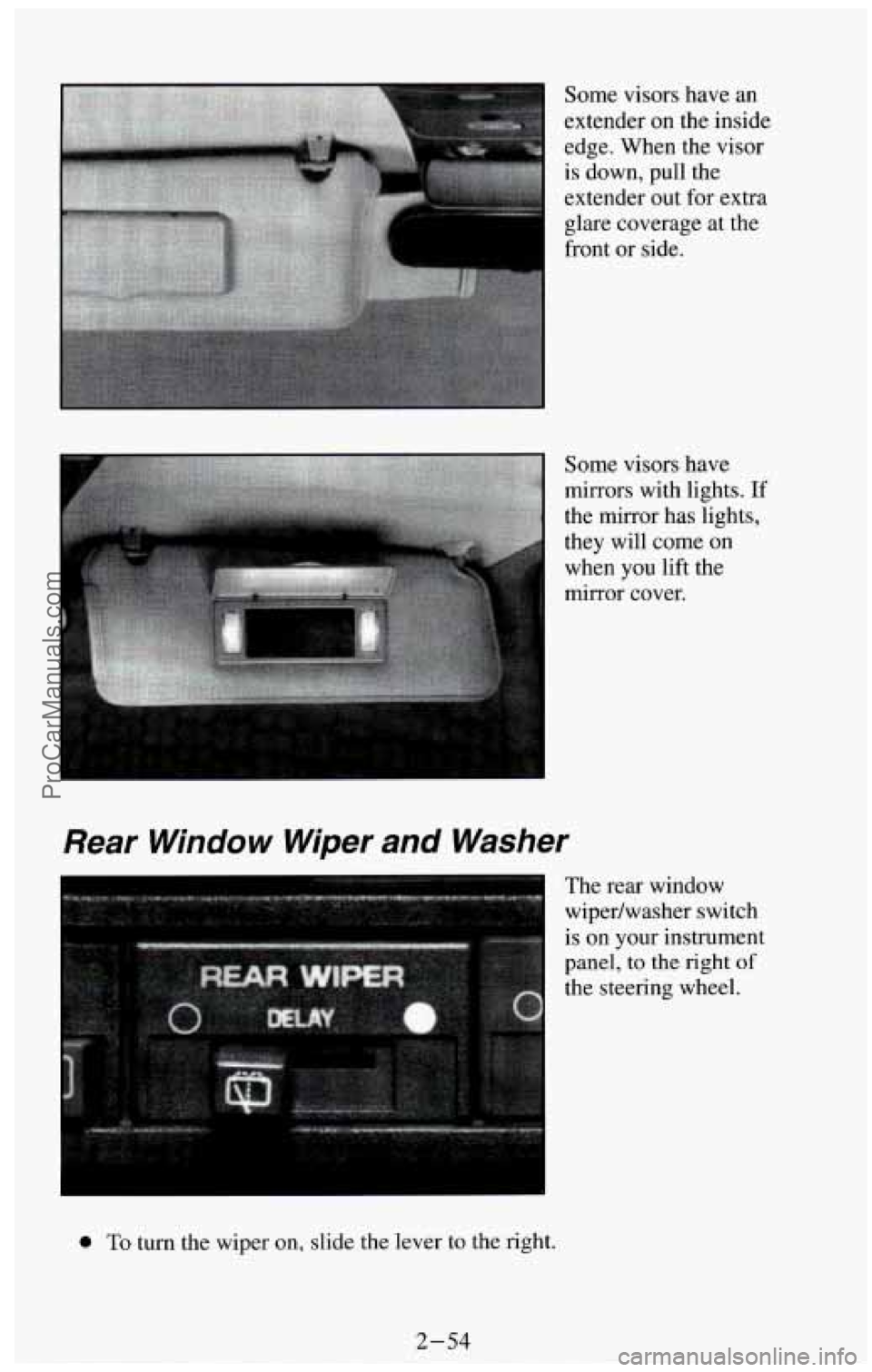
Some visors have an
extender on the inside
edge. When the visor
is down, pull the
extender out for extra
glare coverage at the
front or side.
Some visors have
mirrors with lights.
If
the mirror has lights,
they will come on
when you lift the
mirror cover.
Rear Window Wiper and Washer
The rear window
wipedwasher switch
is
on your instrument
panel,
to the right of
the steering wheel.
0 To turn the wiper on, slide the lever to the right.
2-54
ProCarManuals.com
Page 140 of 385
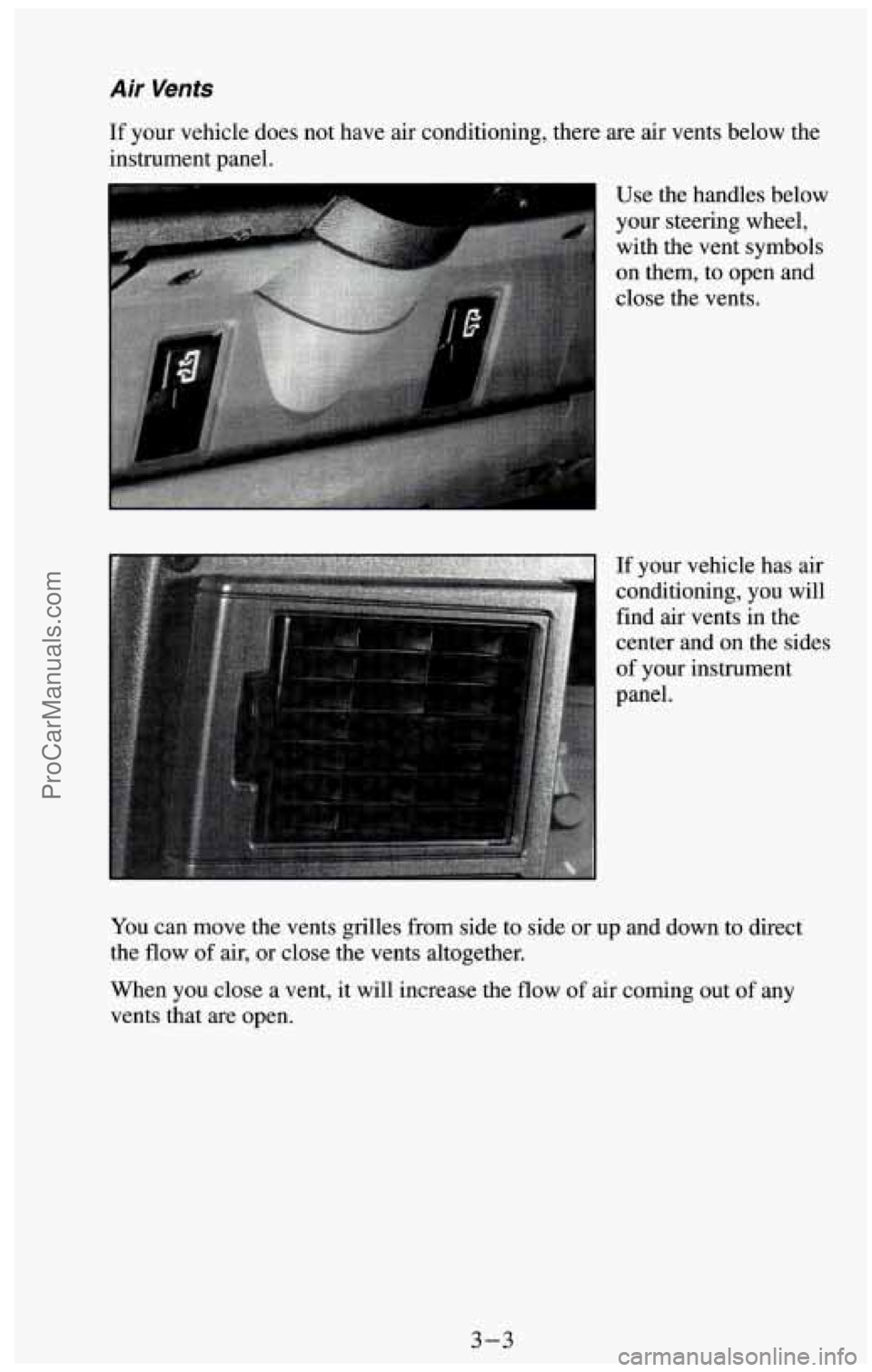
Air Vents
If your vehicle does not have air conditioning, there are air vents below the
instrument panel.
Use the handles below
your steering wheel, with the vent symbols
on them, to open and
close the vents.
%$$$ * 2, ,.' !';."." ,i ':* 2 p*~$;mP$ .',.;"X,, ,., I If your vehicle has air
conditioning, you will
find air vents in the
center and on the sides
of your instrument
panel.
You can move the vents grilles from side to side or up and down to direct
the flow
of air, or close the vents altogether.
When you close a vent, it will increase the flow of air coming out
of any
vents that are open.
3-3
ProCarManuals.com
Page 160 of 385
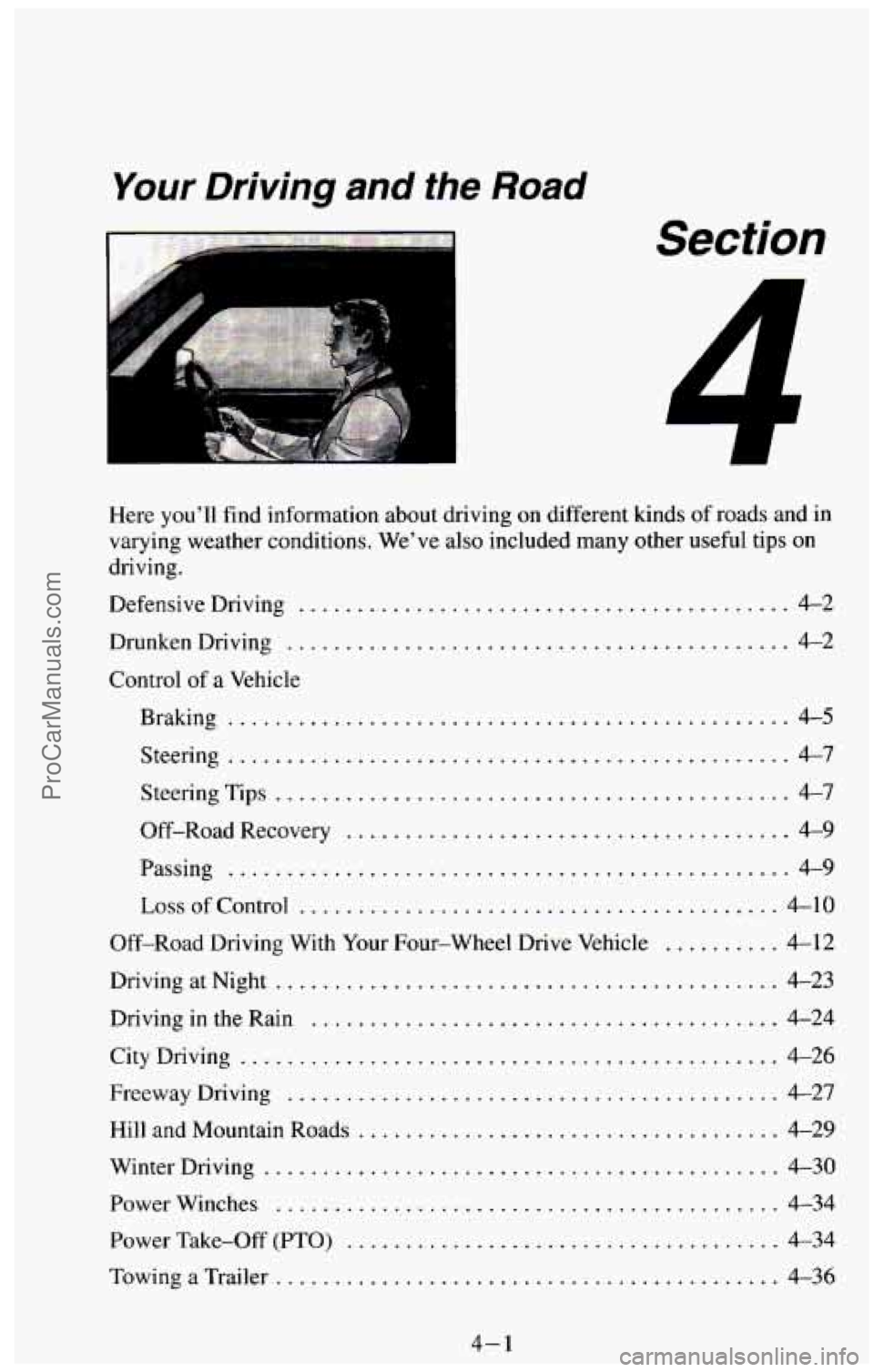
Your Driving and the Road
Section
1
Here you’ll find information about driving on different kinds of roads and in
varying weather conditions
. We’ve also included many other useful tips on
driving .
.............................. 4-2
Defensive Driving ..........
DrunkenDriving ........................................... 4-2
Control
of a Vehicle
Braking
... ........................................... 4-5
Steering
................................................ 4-7
Steering Tips
............................................ 4-7
Off-Road Recovery
...................................... 4-9
Passing
................................................ 4-9
LossofControl
......................................... 4-10
Off-Road Driving With Your Four-wheel Drive Vehicle
.......... 4-12
DrivingatNight
........................................... 4-23
Driving
in the Rain ........................................ 4-24
CityDriving
.............................................. 4-26
Freeway Driving
.......................................... 4-27
Hill and Mountain Roads
.................................... 4-29
Winter Driving
............................................ 4-30
Powerwinches
........................................... 4-34
PowerTake-Off(PT0)
..................................... 4-34
Towing a Trailer
........................................... 4-36
4-1
ProCarManuals.com
Page 166 of 385
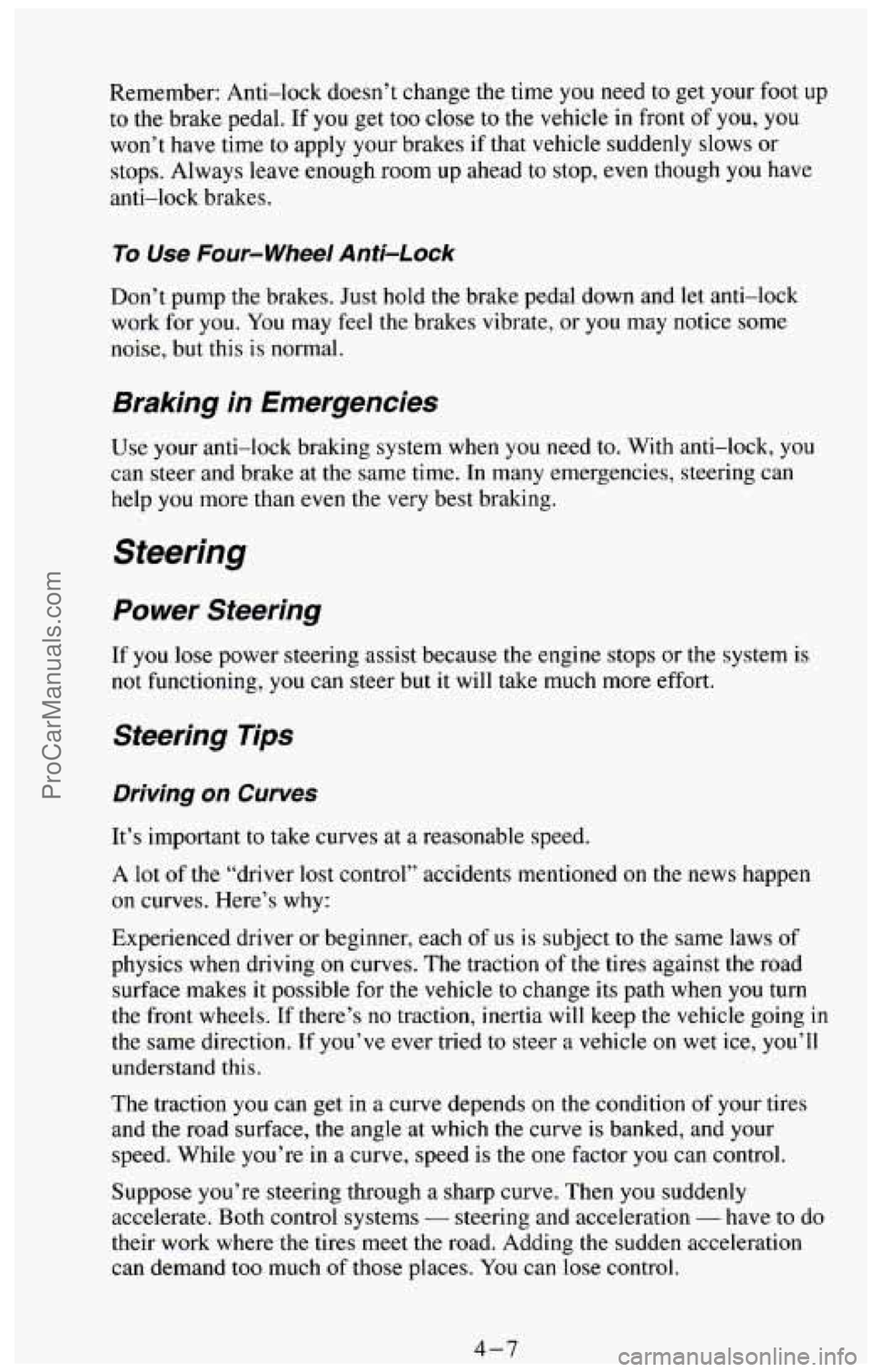
Remember: Anti-lock doesn’t change the time you need to get your foot up
to the brake pedal. If you get too close to the vehicle in front of you, you
won’t have time
to apply your brakes if that vehicle suddenly slows or
stops. Always
leave enough room up ahead to stop, even though you have
anti-lock brakes.
To Use Four-wheel Anti-Lock
Don’t pump the brakes. Just hold the brake pedal down and let anti-lock
work for you. You may feel the brakes vibrate, or you may notice some
noise, but this is normal.
Braking in Emergencies
Use your anti-lock braking system when you need to. With anti-lock, you
can steer and brake at the same time. In many emergencies, steering can
help you more than even the very best braking.
Power Steering
If you lose power steering assist because the engine stops or the system is
not functioning, you can steer but it will take much more effort.
Steering Tips
Driving on Curves
It’s important to take curves at a reasonable speed.
A lot of the “driver lost control’’ accidents mentioned on the news happen
on curves. Here’s why:
Experienced driver or beginner, each
of us is subject to the same laws of
physics when driving
on curves. The traction of the tires against the road
surface makes
it possible for the vehicle to change its path when you turn
the front wheels. If there’s no traction, inertia will keep the vehicle going in
the same direction. If you’ve ever tried to steer a vehicle on wet ice, you’ll
understand this.
The traction you can get
in a curve depends on the condition of your tires
and the road surface, the angle at which the curve
is banked, and your
speed. ,- While you’re in a curve, speed is the one factor you can control.
Suppose you’re steering through a sharp curve. Then you suddenly
accelerate. Both control systems
- steering and acceleration - have to do
their work where the tires meet the road. Adding
the sudden acceleration
can demand too
much of those places. You can lose control.
4-7 ProCarManuals.com
Page 167 of 385
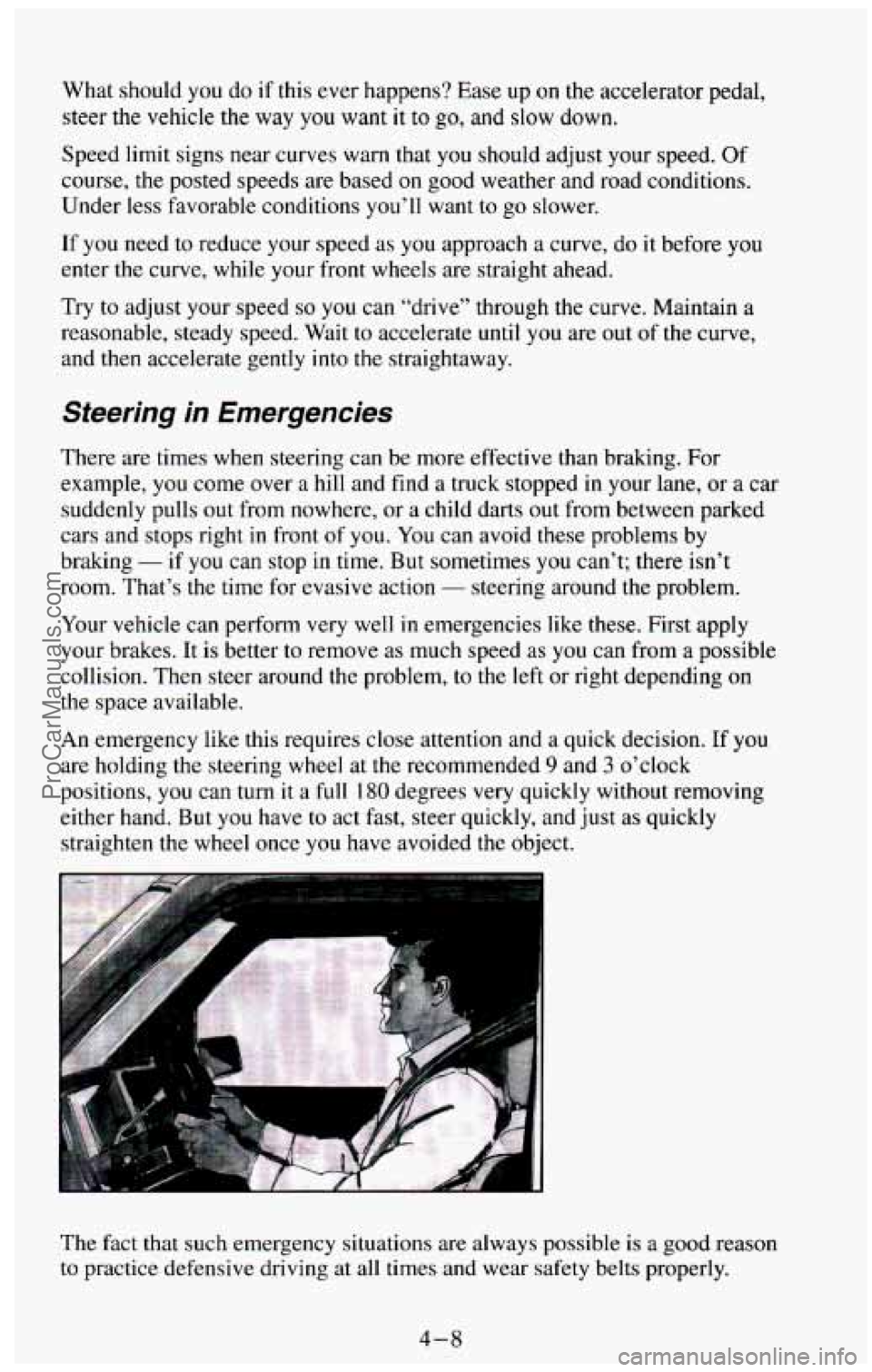
What should you do if this ever happens? Ease up on the accelerator pedal,
steer the vehicle the way
you want it to go, and slow down.
Speed limit signs near curves warn that
you should adjust your speed. Of
course, the posted speeds are based on good weather and road conditions.
Under less favorable conditions you’ll want
to go slower.
If you need to reduce your speed as you approach a curve, do it before you
enter the curve, while your front wheels are straight ahead.
Try
to adjust your speed so you can “drive” through the curve. Maintain a
reasonable, steady speed. Wait
to accelerate until you are out of the curve,
and then accelerate gently
into the straightaway.
Steering in Emergencies
There are times when steering can be more effective than braking. For
example,
you come over a hill and find a truck stopped in your lane, or a car
suddenly pulls out from nowhere, or a child darts out from between parked
cars and stops right
in front of you. You can avoid these problems by
braking
- if you can stop in time. But sometimes you can’t; there isn’t
room. That’s the time for evasive action
- steering around the problem.
Your vehicle can perform very well
in emergencies like these. First apply
your brakes. It is better to remove as much speed as you can from a possible
collision. Then steer around the problem, to the left or right depending on
the space available.
An emergency like this requires close attention and a quick decision. If
you
are holding the steering wheel at the recommended 9 and 3 o’clock
positions, you can turn it a full
180 degrees very quickly without removing
either hand. But you have
to act fast, steer quickly, and just as quickly
straighten the wheel once you have avoided the object.
The fact that such emergency situations
are always possible is ii good reason
to practice defensive driving at all times and wear safety belts properly.
4-8
ProCarManuals.com